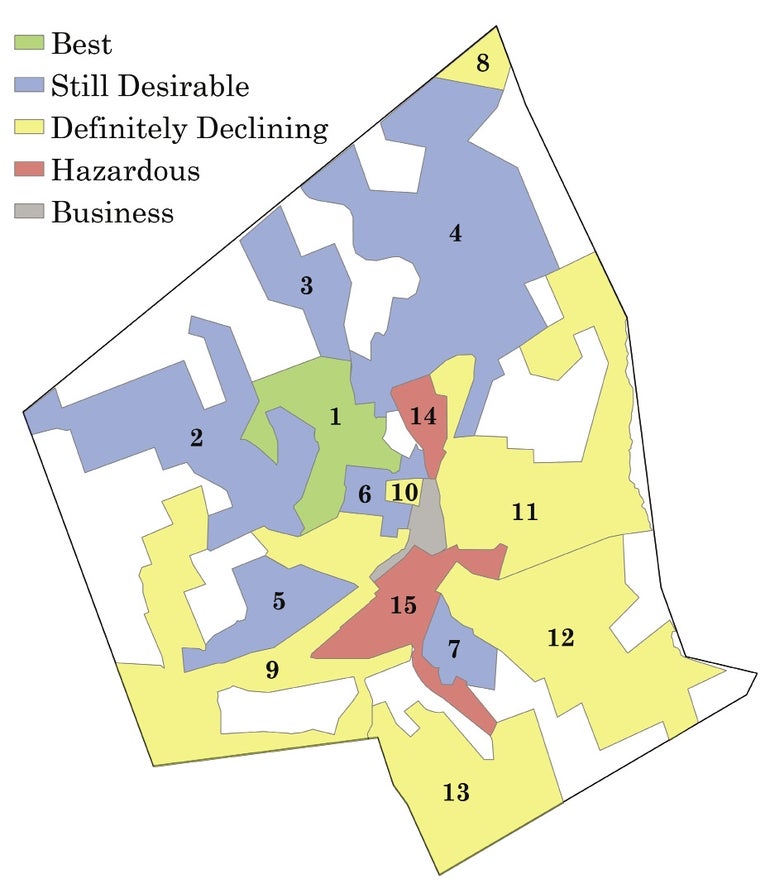As part of the then-new Federal Housing Administration’s effort to give out more home loans, a 1936 assessment of the neighborhoods in Worcester was commissioned by the Home Owners’ Loan Corp.
Get Instant Access to This Article
Subscribe to Worcester Business Journal and get immediate access to all of our subscriber-only content and much more.
- Critical Central Massachusetts business news updated daily.
- Immediate access to all subscriber-only content on our website.
- Bi-weekly print or digital editions of our award-winning publication.
- Special bonus issues like the WBJ Book of Lists.
- Exclusive ticket prize draws for our in-person events.
Click here to purchase a paywall bypass link for this article.
As part of the then-new Federal Housing Administration’s effort to give out more home loans, a 1936 assessment of the neighborhoods in Worcester was commissioned by the Home Owners' Loan Corp.
Below are snippets of the language used in that report to rank neighborhoods, with those ranked highest considered prime for bank investment and those at the bottom hampered by lack of investment for decades.
To read the whole descriptions, see the Worcester Regional Research Bureau’s “Static Income, Rising Costs” report at wrrb.org.

Disclaimer: The language used in these snippets is taken directly from the 1936 Home Owners' Loan Corp. Some of this language may be offensive, and WBJ doesn’t condone its use.
1936 zone: 1
1936 rank: Best
Includes modern-day neighborhoods: Salisbury Street and Hammond Heights
Ranking criteria: “High class residential section. Many of the more well-to-do live in the Hill section … Other homes … are occupied by professional men and business executives.”
1936 zone: 2
1936 rank: Still desirable
Includes modern-day neighborhoods: Tatnuck and West Side
Ranking criteria: “It is occupied by business and professional men … Some of the better class Jewish people are concentrated in the portion around S. Lenox Street.”
1936 zone: 3
1936 rank: Still desirable
Includes modern-day neighborhoods: Indian Lake and Assumption University
Ranking criteria: “Mostly single homes in good condition.”
1936 zone: 4
1936 rank: Still desirable
Includes modern-day neighborhoods: Burncoat and Greendale
Ranking criteria: “A Swedish concentration in the Greendale area … The large Norton Company, manufacturers of grinding machinery and abrasives, is located on New Bond Street (R-8), and although many of these people are employed here, they are skilled artisans and office workers for the most part. Many of the unskilled laborers live in #11 and #13 areas.”
1936 zone: 5
1936 rank: Still desirable
Includes modern-day neighborhoods: Columbus Park and around Clark University
Ranking criteria: “Residents mostly business men and office workers.”
1936 zone: 6
1936 rank: Still desirable
Includes modern-day neighborhood: Elm Park
Ranking criteria: “One of the older sections of the city, containing many fine old residences 50 years old or more, but well kept up and still occupied by descendants of the original owners.”
1936 zone: 7
1936 rank: Still desirable
Includes modern-day neighborhood: Vernon Hill
Ranking criteria: “There is a concentration of Irish in the western section and of Jewish in the southeastern section of this area.”
1936 zone: 8
1936 rank: Definitely declining
Includes modern-day neighborhoods: Northern Indian Hill and Burncoat
Ranking criteria: “A small sparsely settled section housing some of the poorer class.”
1936 zone: 9
1936 rank: Definitely declining
Includes modern-day neighborhoods: Webster Square and Beaver Brook
Ranking criteria: “There is a small concentration of negroes southeast of Beaver Brook playground (J-19) although it is not spreading to adjacent streets. The area contains many of the poorer classes.”
1936 zone: 10
1936 rank: Definitely declining
Includes modern-day neighborhood: Morris Square
Ranking criteria: “Many industrial workers live in this area as well as a few negroes … There is very little tendency for the area to spread beyond its present limits.”
1936 zone: 11
1936 rank: Definitely declining
Includes modern-day neighborhoods: Plantation Street and Chandler Hill
Ranking criteria: “There is a concentration of Swedish industrial workers … Negroes live in a small section … The section along Shrewsbury Street … is inhabited by Italian industrial workers and the laboring class. Toward the business district there is a scattering of Syrians and Armenians.”
1936 zone: 12
1936 rank: Definitely declining
Includes modern-day neighborhoods: Grafton Hill and Union Hill
Ranking criteria: “The Union hill section (P-23) is principally inhabited by Jewish people of the poorer class. South of Oak Hill … is the French section … The area is mostly composed of the poorer class.”
1936 zone: 13
1936 rank: Definitely declining
Includes modern-day neighborhoods: Quinsigamond Village and Broadmeadow Brook
Ranking criteria: “The majority of the residents of this area are Swedish industrial workers of the poorer class.”
1936 zone: 14
1936 rank: Hazardous
Includes modern-day neighborhoods: Indian Lake East and North Lincoln St.
Ranking criteria: “Inhabited by the poorer class. Industrial workers. Cheap tenements in poor condition.”
1936 zone: 15
1936 rank: Hazardous
Includes modern-day neighborhoods: Main South and South Worcester
Ranking criteria: “A concentration of French industrial workers … and a Polish settlement north of Compton Park … Lithuanians occupy the area down as far as Maxwell Street (M-25). The majority are industrial workers and laborers of the poorer class.”
Sources: The University of Richmond provided the Worcester Regional Research Bureau with the original 1936 Home Owners' Loan Corp. report; Clark University also provided the report to Worcester Business Journal

